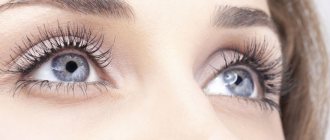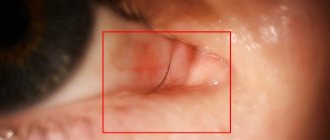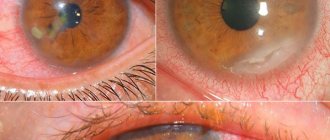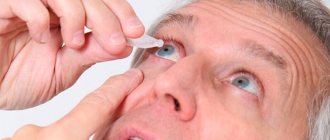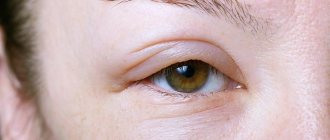Sometimes our eyes need help.- They begin to actively redden and become inflamed, sometimes tearing and itching appear in the area of the organs of vision.
- Vasoconstrictor eye drops help these processes, if not completely eliminate, then at least reduce the symptoms of certain diseases.
- They just need to be applied according to certain rules and for a certain time.
- The main symptom when this drug is necessary for drug treatment is redness of the eyes.
Indications
Vasoconstrictor eye drops reduce eye redness and swelling, but do not act on the cause of their appearance.
Vasoconstrictor eye drops are designed to reduce redness and swelling caused by:
- for conjunctivitis, blepharitis, allergic inflammation of the eyes;
- as a result of exposure to external irritants (smoke, chlorinated water, bright light, contact lenses).
How to use
Vasoconstrictor drops are used for redness of the eyes caused by increased pressure in the blood vessels and their dilation. Increased blood pressure can occur for a variety of reasons. For example, due to ordinary fatigue or the development of serious ophthalmological diseases.
For external causes of redness
There are many reasons for redness that are not caused by any diseases. These include:
- Fatigue, visual overload caused by prolonged viewing of TV, reading, working on a computer, driving, sewing, knitting and other activities that require eye strain.
- Adverse external influences - cold wind, hot and dry air, dust, smog, working with paints and other aggressive substances.
- Use of contact lenses.
- Taking certain medications.
- Smoking and alcohol abuse.
- Muscle tension during severe coughing or crying.
- Allergy.
In all of the above cases, no special treatment is required to relieve redness. It is enough to use vasoconstrictor drops several times a day.
Instillations are carried out as needed, but their frequency should not exceed 5 times a day. 1-2 drops of the medicinal solution should be injected into each eye.
As a rule, the use of drops allows you to get rid of redness and discomfort in the eyes within 3-7 days. It is important to eliminate the cause of the problem: reduce the time you watch TV, ensure proper sleep, and refrain from drinking large amounts of alcohol and smoking.
To prevent infection from entering the irritated eye, do not touch them with dirty hands. Otherwise, an inflammatory process may develop in the organs of vision, which will require complex therapy using antibiotics and other medications to eliminate it.
For ophthalmological diseases
Redness of the eyes may indicate the development of an ophthalmological disease. Therefore, if redness and discomfort are accompanied by pain, discharge from the eyes, visual impairment, or other suspicious symptoms, you should visit an ophthalmologist.
The most common pathologies in which red eyes are observed are:
- Blepharitis - can be transmitted from a sick person to a healthy one, or develop as a result of allergies, corneal damage, autoimmune diseases, inflammatory processes in the choroid of the eyes. In the treatment of blepharitis, vasoconstrictor drops are part of complex therapy; they are used to eliminate local symptoms.
- Conjunctivitis, which can be caused by bacteria, viruses, allergens, or a person with conjunctivitis. Depending on the cause of the disease, the doctor prescribes antiviral, antibacterial or antiallergic drops. Vasoconstrictor medications in this case only help to reduce unpleasant symptoms.
- Glaucoma is a serious visual impairment that requires long-term and complex treatment. Vasoconstrictor drops cannot be used for this disease, as they increase intraocular pressure.
Other conditions that may cause red eyes include:
- diabetes;
- vascular dysfunction;
- head injuries;
- hypertension;
- cold.
It must be taken into account that vasoconstrictor drops are not able to eliminate the causes of diseases. Their main purpose is to eliminate redness, discomfort and swelling of the eyes.
Such drugs should be used strictly in accordance with the dosages recommended in the instructions. A feature of all vasoconstrictor drops is the high risk of developing the body’s addiction to their active substances in case of long-term use. In this case, the medicine will have the opposite effect - redness, swelling and other symptoms may appear even stronger. As a result, persistent expansion of the conjunctival membrane may occur, and the inflammatory process will take a chronic form.
Features of action and application
The composition of vasoconstrictors usually includes α-adrenergic agonists - substances that act on the receptors of the vascular walls. As a result of this effect, the lumen of the blood vessels narrows, which eliminates swelling and redness of the mucous membrane of the eyes, and reduces other symptoms of inflammation - discomfort, burning, itching, lacrimation.
Vasoconstrictor drugs eliminate symptoms, but do not act on the cause of their occurrence, do not treat the underlying disease, and are used exclusively to reduce/eliminate the clinical manifestations of the disease in combination with other medications.
Ophthalmologists prescribe eye drops with a vasoconstrictor effect in short courses. With prolonged use (longer than 3-5 days), addiction develops, persistent dilatation of the vessels of the conjunctival membrane may occur, as a result of which the redness will become permanent.
In addition, with the constant use of drugs in this group, the course of the underlying disease may worsen, since the narrowing of the lumen of blood vessels disrupts the blood supply and nutrition of the tissues of the eye. Any eye solutions with a vasoconstrictor effect should be used only as prescribed by a doctor.
Vasoconstrictor eye drops: list and description of drugs
Swelling and redness of the mucous membrane of the organs of vision is the result of an increase in blood vessels. This pathology process can appear for various reasons. As a rule, these are injuries, dust particles, and sun rays. In order to get rid of these symptoms, ophthalmologists prescribe vasoconstrictor eye drops to their patients. We will consider below what drops a doctor may prescribe.
Single action drops
These are drops for topical use that allow you to narrow blood vessels, that is, they create a vasoconstriction effect. After instillation, the vessels of the conjunctiva and sclera narrow, thereby eliminating swelling and redness.
Visine
If the organs of vision are irritated by some external factors (dust, thick smoke, cosmetics or contact lenses), or an allergic reaction occurs (due to hay fever or pollen), then Visin is indicated for use.
Apply 1-2 drops 2 to 3 times throughout the day . If contact lenses are worn, they are removed 20 minutes before instillation. Since under the influence of drops, the transparency of the lenses is likely to be impaired. The course of treatment is 1-2 weeks .
The composition includes the active ingredient -
tetrizoline hydrochloride (0.5 mg per 1 ml of the drug).
Drops are produced in a 15 ml bottle. The drug acts as follows: the effect occurs 3-4 minutes after application and lasts up to 10 hours. Conjunctival hyperemia and decreased swelling are noted. The feeling of itching, irritability and burning almost goes away.
Contraindications
Vasoconstrictor eye drops are not prescribed for:
- children (age restrictions for each product are individual, indicated in the instructions for the drug);
- pregnant and lactating women;
- people with individual intolerance to the components included in the drops;
- patients diagnosed with dry eye syndrome (vasoconstrictors provoke even greater dryness of the mucous membrane) or glaucoma (vasoconstriction leads to increased intraocular pressure).
Diabetes mellitus, arterial hypertension, hyperthyroidism and other diseases of the cardiovascular, endocrine and other body systems may also be contraindications to the use of drops. Before using the medicine, you should carefully read the list of contraindications specified in the instructions.
If the redness of the eyes is due to drying out of the mucous membrane due to constant work at the computer, drops with a vasoconstrictor effect cannot be used - this will only aggravate the condition.
For redness of the eyes associated with external causes
There are several reasons for this inflammatory process, sometimes they differ from each other quite noticeably:
- TV and , in particular, computers can become enemies of your vision if you are near a monitor or screen for more than 6 hours a day;
- negative environmental situation ; exhaust gases from cars, emissions of harmful substances into the atmosphere from enterprises - all this irritates the mucous membrane of the organ of vision;
- Redness is often caused by an allergic reaction; it can be either seasonal or sudden when an irritant appears;
- dry eyes due to dysfunction of the lacrimal glands;
- mechanical damage to the cornea;
- improper wearing of contact lenses;
- vascular diseases of various pathologies;
- cold or dry climate , unusual for the body.
For ophthalmological diseases
- conjunctivitis. This is a purulent inflammation of the mucous membrane; It can be of allergic or viral or bacterial origin. In all cases, the use of drops gives a certain positive effect;
- blepharitis. This inflammation of the eyelid margin often causes intense redness;
- glaucoma. This disease is characterized primarily by an increase in intraocular pressure, due to which small vessels rupture;
- colds, diabetes.
Principle and duration of action
The main component of such drugs are adrenergic agonists .
These substances target receptors on the walls of blood vessels .
As a result of this active effect, redness, swelling, itching and burning are quickly localized . The person ceases to experience persistent discomfort.
However, frequent and long-term use of these medications may eventually cause the opposite effect.
After 5 days, the drops begin to become addictive, and then even provoke a complication of the disease. The redness may become permanent. Therefore, you should not get carried away only with this method of treatment.
In addition, eye drops do not treat the disease itself , which causes redness, but only its symptoms .
Otherwise, the benefit from the drug will only be temporary, and the disease, having adapted to it, will develop with renewed vigor.
Possible contraindications
Before you figure out how and what drops should be used, you need to consider the cases under which they are not recommended to be used.
There is a list of conditions and diseases for which such drugs are contraindicated:
- they should not be taken by pregnant or breastfeeding women ;
- with great caution they are prescribed to children in a certain dosage and at a certain age ;
- with glaucoma - narrowing of blood vessels provokes an increase in eye pressure;
- for cardiovascular diseases and arterial hypertension ;
- in case of detection of diabetes mellitus ;
- for dry eye syndrome; this is the name for serious inflammation of the lacrimal glands, which can be treated for a long time with other drugs;
- drops of this kind are strictly contraindicated for people suffering from individual intolerance to naphazoline and tetrizoline - these drugs are the basis of such drugs.
But there are also opinions to the contrary. In any case, treatment here must be approached on a purely individual basis.
The most effective means
Visine
- Visine is one of the most common broad-spectrum drugs;
- relieves redness, swelling, itching;
- Visible improvement begins within 5-7 minutes;
- the drug is active for 5-8 hours;
- especially effective for allergic reactions and conjunctivitis;
- has a significant list of side effects: pupil dilation, sometimes pain, burning, blurred vision;
- Pregnant women should not use it;
- average price – 280 rub.
Polinadim
- combined action drug – contains naphthyzine and diphenhydramine;
- effective against allergies;
- It is not recommended to use for longer than 5 days;
- 1 drop is instilled 2-3 times a day, for children over 2 years old - 1 time;
- may cause itching and burning;
- pregnant women - only in extreme cases;
- the bottle cannot be frozen and stored after opening for more than 1 month;
- In pharmacies these drops cost about 80 rubles.
Okumetil
- a combination medicine consisting of naphazoline, diphenhedramine and zinc sulfate;
- in addition to the main one, it also has a disinfecting effect;
- apply no longer than 3 days;
- instillation mode – 1 drop 3 times a day;
- especially contraindicated for bronchial asthma;
- price 150 rub.
Octilia
- octilium begins to act within 2 minutes;
- applied 2 times a day;
- most active in conjunctivitis;
- It is not recommended to go out into the cold after use;
- contains antiseptic components;
- in pharmacies it costs 300 rubles.
Naphthyzin
- the most affordable remedy;
- the drug has proven itself well for mechanical eye injuries;
- It is prohibited to use more than 3 times a day;
- causes very rapid addiction depending on the individuality of the patient’s body;
- Causes rapid pupil dilation, so it should not be used immediately before driving a car or working on a computer.
- costs from 30 rubles.
Visomitin
- vizomitin is one of the most effective and gentle drugs;
- often prescribed to older patients;
- for computer syndrome does not give negative side effects;
- enhances the effect of concomitant medications;
- dosage and frequency of use are interrelated with other medications:
- In pharmacies it sells from 500 rubles.
Alomid
- mainly fights allergic reactions;
- has virtually no side effects;
- is not addictive;
- can be used for up to 4 weeks;
- after instillation in the area of the pupil, discomfort is possible;
- costs 240 rubles.
Vidisik
- Vidisik relieves dryness of the mucous membrane of the eye;
- ineffective for allergies
- causes visual impairment in some patients
- costs 250-300 rubles.
List of inexpensive drugs with improved action
- tobrex; the price of the drug is 150 -170 rubles, but in comparison with the price its effectiveness is very high;
- tauphone; costs from 130 rubles, but can be used for a month;
- tsipromed; can be purchased for 140 rubles, effective against bacterial infection;
- pure tear ; the drug is almost similar in composition to natural tears, therefore it does not cause allergic reactions; available from 140 rub.
Types of vasoconstrictor eye drops
Vasoconstrictor eye drops based on the main active ingredient can be divided into:
- products based on tetrizoline - Vizin, Octilia, Visoptic, Montevisin, Neosin;
- preparations with naphazoline – Naphthyzin;
- combined agents – Okumetil, Polinadim.
Visine
A drug based on tetrizoline, a substance that has a stimulating effect on α-adrenergic receptors. The drug is characterized by a pronounced vasoconstrictor and anti-edematous effect, slows down the production of eye fluid, and dilates the pupil. The therapeutic effect of the drug develops within a minute after instillation and lasts 4–8 hours.
Directions for use: 1-2 drops 2 to 4 times a day, no longer than 4 days.
If the dose, frequency and duration of use are exceeded, the drug causes systemic side effects - increased blood pressure, increased heart rate, nausea, agitation and confusion.
Octilia
An analogue of Visine based on tetrizoline. In addition to the vasoconstrictor component, the drops contain chamomile and linden extracts, which effectively relieve inflammation, burning and soreness, and soothe irritated eyes. The product begins to act a few minutes after instillation, the therapeutic effect lasts 4–8 hours.
Directions for use: 1-2 drops 2-3 times a day, no longer than 4 days.
When using drops for a longer time, the likelihood of developing side effects increases - eye pain, tearing, increased swelling and redness, increased intraocular pressure and deterioration of visual function.
Naphthyzin
Naphthyzin vasoconstrictor eye drops should be used only as prescribed by your doctor.
Vasoconstrictor drops based on naphazoline. The product effectively eliminates swelling and redness, reduces tearing, burning and discomfort, and dilates the pupil. The therapeutic effect develops a couple of minutes after instillation of the solution and lasts several hours.
Directions for use: 1-2 drops 2-3 times a day, no longer than 3-4 days.
The drug has a wide list of contraindications; in case of overdose, it provokes the development of systemic side effects - headache, nausea, heart rhythm disturbances, increased blood pressure, insomnia.
Okumetil
A combination drug containing:
- naphazoline (vasoconstrictor component);
- diphenhydramine (antiallergic component, H1-histamine receptor blocker);
- zinc sulfate (anti-inflammatory and antiseptic).
The components included in the drug act comprehensively: they reduce the intensity of the inflammatory process, disinfect, eliminate redness, swelling, itching, burning, tearing and other unpleasant symptoms that occur with allergies, irritation and inflammatory diseases of the eyes.
Directions for use: drops into the affected eye 2-3 times a day for 3 days.
After instillation, the components of the solution are absorbed into the bloodstream and have a systemic effect. In this regard, eye drops have a wide range of contraindications (epilepsy, bronchial asthma, prostate hyperplasia, diseases of the cardiovascular system, stenosis of the bladder neck and others) and are used strictly as prescribed by the doctor.
Polinadim
Polinadim vasoconstrictor drops effectively eliminate redness and swelling in allergic and infectious eye diseases.
Combined drops containing naphazoline (vasoconstrictor) and diphenhydramine (H1-histamine receptor blocker). The drops have a pronounced vasoconstrictor and antihistamine effect, quickly relieve swelling, reduce itching and lacrimation.
Mode of application: drop by drop every 3 hours until the intensity of symptoms decreases, then drop by drop up to 3 times a day, no longer than 5 days.
Exceeding the dosage and frequency of use can provoke clouding of the cornea, increased local adverse reactions (burning in the eyes, deterioration of visual function). It is also possible to develop systemic effects (increased heart rate, increased blood pressure, headache and dizziness, tremor, nausea, drowsiness), especially in children and the elderly.
Redness of the eyes occurs not only as a result of exposure to irritating external factors, but also with various ophthalmological diseases - conjunctivitis, uveitis, blepharitis, corneal ulceration, glaucoma. Before using vasoconstrictor eye drops, you should consult an ophthalmologist to make an accurate diagnosis.
The specialist will determine the exact cause of redness and swelling, and in addition to symptomatic vasoconstrictors, will prescribe medications to treat the underlying disease that caused the unpleasant symptoms. Improper treatment can lead to worsening inflammatory processes in the eye, the development of complications and deterioration of vision.
Safe treatment of dry eye syndrome
A unique drug based on the patented extract MaquiBright® has relatively recently appeared on the Russian market. These are Delfanto® capsules that contain more than 35% antioxidants.
The drug has been clinically tested. It has a convenient form of administration and a completely natural composition. Just 1-2 capsules of Delfanto® per day will help normalize the functioning of the lacrimal glands and increase the production of your own tears.
2 weeks after starting to take the drug, patients notice the first improvements. Within a month, the severity of dry eye symptoms decreases by 45%, the fear of bright sunlight, itching in the visual area, and redness are eliminated.
Delfanto® is recommended for patients whose activities involve increased visual stress. Capsules serve as an excellent prevention of the development of dry eye syndrome. Therefore, if you do not want to see red and swollen eyes in the reflection, experience itching and burning, start drinking Delfanto® today.
The most effective means
Currently, pharmacies offer a huge range of eye drops with a vasoconstrictor effect. The most effective among them are:
- Visine - drops based on tetrizoline, have a temporary vasoconstrictor effect, relieve swelling and eliminate discomfort caused by irritation and eye strain. The drug can also be used for irritations caused by allergens. The product should not be used by people prone to pressure changes. It is not recommended to use Visine for more than 4 days, as these drops can be addictive. The price for a 15 ml bottle is 330 rubles.
- Octilia - the product contains tetrizoline, as well as linden and chamomile extracts. It has a quick action and relieves swelling and redness of the eyes well. Contains antiseptic components, due to which it can be used in the treatment of conjunctivitis. Do not use for dry eyes, glaucoma and in children under 3 years of age. The cost of an 8 ml bottle is 325 rubles.
- Okumetil is a medicinal solution based on naphazoline, zinc sulfate and diphenhydramine. It has anti-inflammatory, antiseptic and pronounced vasoconstrictor properties, effectively relieves swelling. Prescribed for conjunctivitis and eye irritations. The price for a bottle with a capacity of 10 ml is 220 rubles.
- Naphthyzin - drops for eyes and nose contain naphazoline. The product helps reduce the severity of eye irritation - watery eyes, redness, burning, swelling. Has the ability to dilate the pupil. The price per bottle is about 60 rubles.
- Polynadim - drops based on diphenhydramine and naphazoline. Helps reduce swelling, itching, and lacrimation. Prescribed for conjunctivitis and eye irritations, including those caused by allergies. Like all vasoconstrictors, Polinadim is not prescribed for glaucoma. Contraindications also include pregnancy, age under 2 years, dry eye syndrome. The cost of a 10 ml bottle is 65 rubles.


